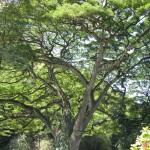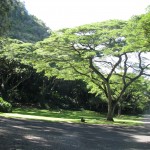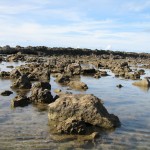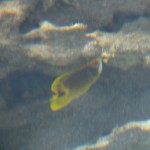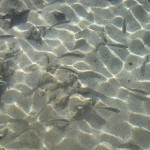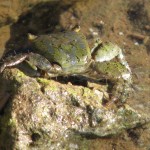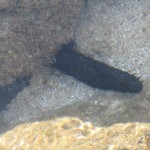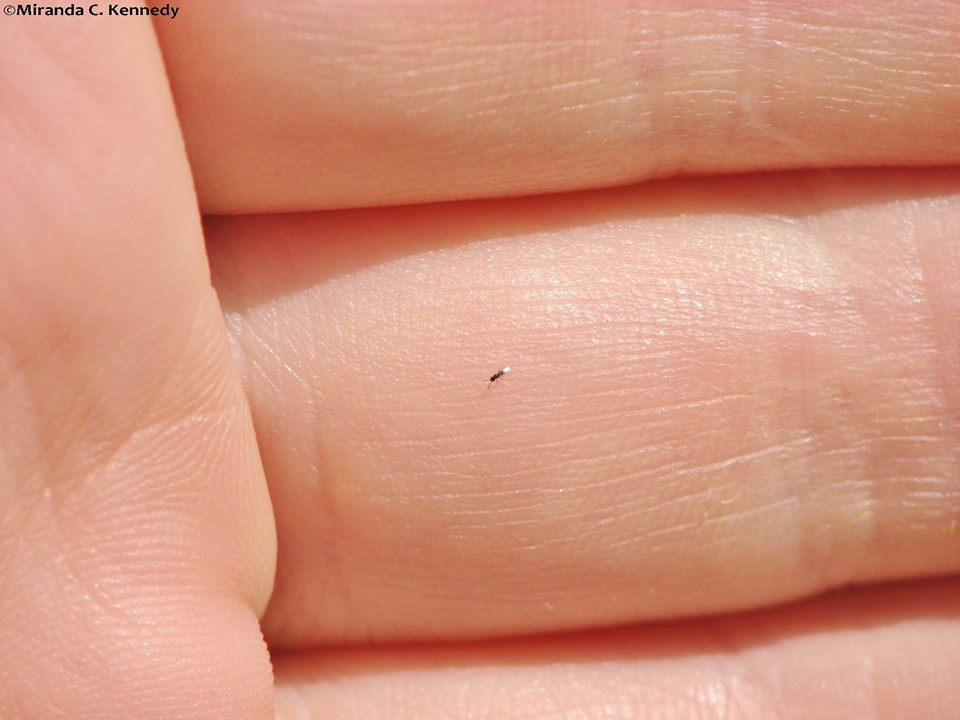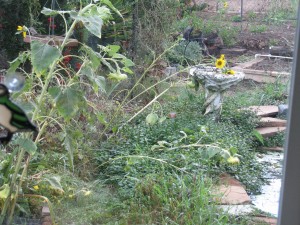-
More Oahu
As the time is three hours ahead of San Diego time, and being an early riser anyway, I’m up at 5 am with the dawn chorus. I’m able to walk out onto the beach in the dark, do my yoga stretches in the sand, swim a little in the man-made coves which create safe swimming areas away from the riptides, and watch the sun brighten the day. On Wed. we drove to the North side of the island, to Waimea Falls botanical park. An incredible collection of plants arranged in gardens representing the flora of different islands. It was very humid but lovely. We ate the now-warmed leftovers from dinner at the Cheesecake Factory in the car down the road at Shark Cove. There are incredible tidepools there. We waded, taking care not to slip on the craggy lava rock. I collected an impressive array of mosquito bites, but I”m always happy to contribute to local sustainability. Then we drove around the Eastern perimeter of the island, which is where the Hawaiians live. Incredible, majestic scenery. The mountains have real presence. When it looked as if we were going to drive around a curve directly into the mountain, there was the Wilson tunnel. Then we popped out to the other side with a completely different view, and on back to Waikiki. In the interest of time I’ll post the photos gallery style below.
Dawn Diamondhead as the sun rises in back of it Daylight reaches the hotels Paddleboarding, by the people who invented surfing Wailea Falls Monkeypod trees Water gardens Beautiful flowers Who says trees aren’t alive? Vines like a barberpole Heliconia Another beautiful ‘meadow’ Shark cove tidepools Parrotfish through the water Fishes and light Don’t worry, be crabby A sea cucumber or slug Yes, these craggy mountains are full of spirit What a backyard view for the native side of the island! I didn’t know it, but we’d be going under these mountains! Watch a video going the other way at http://www.youtube.com/watch?v=J671kJA_HRo Sunset on incredible mountains -
Traveling Again: Oahu

Oahu from the air I’m visiting my son in Oahu for a few days… good excuse, huh? After some of the usual flight and traveling difficulties, and some very welcome sleep, I’m sitting in my pre-dawn hotel room listening to the morning chorus of birds and Waikiki traffic. This is my fifth time visiting the isles; my third here. All over the hotel, the beach, the vendors is a memory of being here with my parents at various stages of our lives. My mother loved Hawaii so much. So different from shoveling snow in New Jersey layered in sodden cold clothing. If she had more than one life to live I’m sure she and Dad would live on Maui. I was here last with them when my children were small, just after my divorce. It feels like a hundred years ago. As it is, I’ve left the mainland as a woman who is forty-something, and returning a fifty year old. I need the warm scented breezes to cushion the impact.
Waikiki is like any American resort: expense and commercialism and pretense of class turning its back on the dirt, pollution, noise and poverty that seeps through cracks from the other side of the International Marketplace just across the street. Tourists shouldn’t roam far at night. Making Hawaii a state did it no favors; I agree with the natives that they’ve lost so much. Next time that I visit it will be to a bed and breakfast in the hills where there is greenery, birds and quiet.
Today we’ll go to one of the beautiful areas of the island and see some of that incredible nature that clings on to this poor volcanic rock. Hike and birdwatch and listen to the lack of human machines, if possible. Feel the freedom of not being in competition with slender young women, for at my age I am invisible, which is comforting. Let the scent of the flowers seep inside. Enjoy the company of my son as an adult. Here are a few photos of my first afternoon here:
A very long airplane wing, with Oahu below Pearl Harbor from the plane Orchid lei The historic Moana Surfrider Rockers out front Old Banyon tree in courtyard of hotel My room at the Moana Surfrider Banyons Banyon trees at the International Marketplace Where I bought a tofu spring roll snack Hu-la-lu ice cream, featuring pineapple, coconut and other tropical flavors Birds, mostly invasive species, feeding on seed in a park Waikiki and Honolulu Waikiki and Top of Waikiki revolving restaurant Oahu from the air -
To Land’s End

The Land's End Hotel This will be the last of my Cornwall travel experiences: Land’s End. At the very south-west tip of Cornwall is Land’s End. When you stand at the clifftop of Land’s End and face west, the next main body of land is the east coast of the United States.

No main land until the USA It was astoundingly beautiful, with cliffs full of history, danger and excitement. We stayed at the Land’s End Hotel (http://www.landsendhotel.co.uk/) which perches at the edge of the cliff.
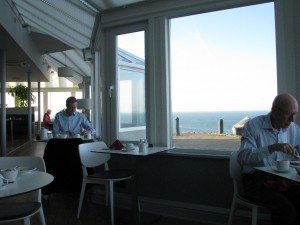
Breakfast in the dining room with an incredible view 
Treacle Tart... yum! The dining room windows and our room window faced the ocean and the setting sun.

Sunset over the Isles of Scilly From the hotel you could see a small group of rocks and a lighthouse.
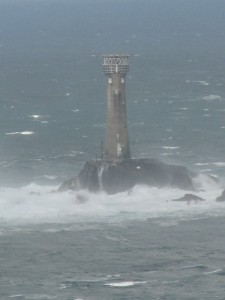
Many a sailor's saviour I watched both the moon and the sun set every day we were there.

The moon setting pre-dawn from our room On good days you can see the outline of the Isles of Scilly, which we regretfully didn’t have a chance to visit. Although we still were buffeted about by the remaining winds of the hurricane the weather was beautiful.
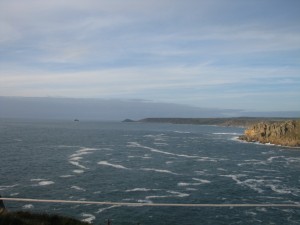
Wind-tipped waves In Cornwall they say that if there are clouds on the horizon it is going to rain, and if there aren’t then its raining already. We had some predictable showers, most notably in the morning, but nothing to complain about. And the sea… oh, the sea! We spent our last morning there walking the cliff paths between rock and heath, which even in September were quilts of purple and yellow flowers.
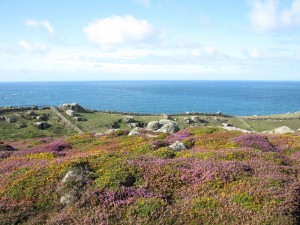
Gorse and heather in glorious bloom The rock breaks into large chunks rather than crumbling away, which creates massive natural sculptures on which you can imagine giants of legend sitting, chin on fist, mesmerized by the waves.
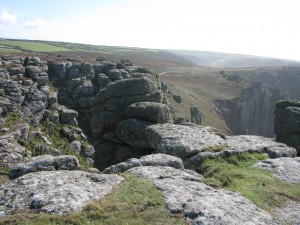
Rocks like giants' chairs The relentlessly pounding surf formed caves which made the waters home to smugglers.
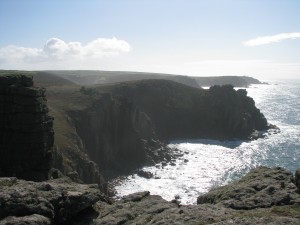
These be smuggler's waters! 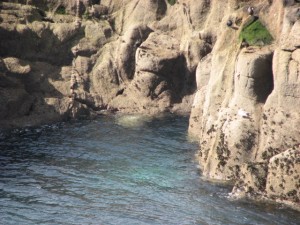
Natural caves were great for smugglers The giant rock cliffs formed enormous tombstones for the countless sailors of countless ships, all foundered on the hidden stones by wild tides, since man first took to the sea.

No guardrails on the trail to disturb the beauty The cliff pathway followed the edge without restraints or hand-holds of any kind, and it led all the way to the historic southernmost town of Mousehole (pronounced MOWzzle).
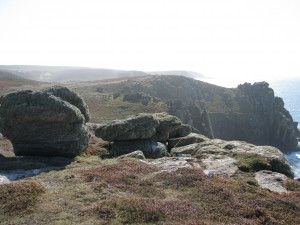
The cliff path leads several miles to Mousehole Although the wind kept the number of birds low, there still were the pelagic inhabitants using the cliffs for protection and warming themselves in the sun.

Seabirds resting 
Rocky islands are perfect for seabirds A RSPB (Royal Society for the Protection of Birds) center sat in the hotel complex on the cliff from where my daughter sighted a peregrine falcon.

RSPB Center, with an inviting Blue-footed Booby at the entrance The area around Land’s End is mostly empty, with a few farms and another historic hotel The First and Last (depends on which way you are going!) which boasts of a smuggler’s tunnel to the sea and the horrible end of the woman who turned them in to the Crown.

Epitaph for a squealer There are people who travel from Land’s End up to the farthest point on mainland Britain, John O’Groats, and call themselves End-to-Enders. Many do it for charity; some walk or bike. When we visited Scotland several years ago we took the ferry from John O’Groats to the Orkney Islands, so we’ve been at each end, just not in direct line. This Cornwall coastline is the most dramatic I’ve ever seen.

Incredible colors and textures I left part of my heart in Cornwall; something in the heartiness of the people and creatures that live there, braced against the wind and weather, calls to me.

A tough bunny I could have spent days like the giants, staring out at the roiling waves, watching the next storm blow in.

Mesmorizing As long as I could be inside nice and cozy when it hit! I want to thank my daughter for the use of many of these photographs, and for being such a good traveling companion and navigator.

Sunset -
Freezing Apples
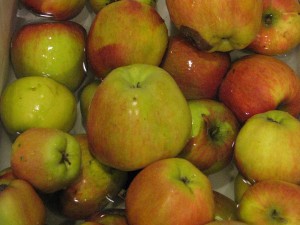 Growing your own food is marvelous. Having it all come ripe at the same time is not. My apple tree is producing well this year, and the apples need to be stored in some way. Since I don’t have a cold cellar, I need to can or freeze them. My plan was to can apple slices in either a light water and sugar mixture, or make Pie-In-A-Jar pie filling. However, two days of 101 degree heat took the wind out of my sails, and used up the time I had allotted for canning. The apples, however, are still there. So I froze them instead, which is probably the better solution because it doesn’t add any sweetener ahead of time.
Growing your own food is marvelous. Having it all come ripe at the same time is not. My apple tree is producing well this year, and the apples need to be stored in some way. Since I don’t have a cold cellar, I need to can or freeze them. My plan was to can apple slices in either a light water and sugar mixture, or make Pie-In-A-Jar pie filling. However, two days of 101 degree heat took the wind out of my sails, and used up the time I had allotted for canning. The apples, however, are still there. So I froze them instead, which is probably the better solution because it doesn’t add any sweetener ahead of time.Another good time saver if you are keeping apples for pies, is to make the apple pie filling, pour it into a pie pan and freeze it. After freezing, slip it out and into a freezer bag. When it comes time to bake, make the crust (which you actually can do ahead of time and freeze separately as well) and slip in the frozen pie filling. Add baking time.
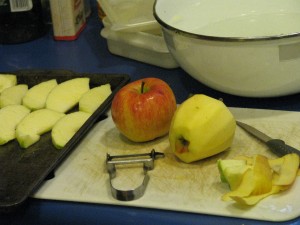
The best apple peeler I’ve ever had was purchased at the Del Mar Fair many years ago and given to me as a gift. It is easy to hold (I have arthritis) and I can zip through peel like nobody’s business. I know that design (in photo) is sold elsewhere, so don’t wait for the Fair.
Freezing ApplesAuthor: Diane KennedyRecipe type: Side dish or dessertPrep time:Total time:Freezing ripe apples allows you to have easy, ready-to-use apple slices whenever you want.Ingredients- Apples
- A bowl full of cold water
- A lime or lemon, or a teaspoon of apple cider vinegar
- cookie sheets that fit into your freezer
- Freezer bags
Instructions- Add the juice of a lime or small lemon, or the vinegar, to the bowl of water.
- Wash the apples.
- Peel several apples and drop them into the water to keep from browning.
- When bowl is full, slice apples into wedges that would be appropriate for pie, and drop the slices into the water.
- Place dipped slices onto a cookie sheet so that they don't overlap.
- Freeze cookie sheet with apples (about 20 - 30 minutes).
- Remove apples from sheet, place in marked freezer bag, flatten and squeeze out extra air, and place flat in freezer so that the bags can be stacked.
- Keeps for about a year.
-
Stuck Rat

I wasn't sure what I was seeing from the kitchen. Tree rats are part of life in a rural area. They have cost me hundreds of dollars in damage to my cars, since they love eating the tubing and enjoy the warmth inside for nesting. However they have their place… just not in my stuff. So when I looked out the window this morning while eating breakfast and saw a very un-birdlike creature in the hanging bird feeder, I had to go outside and see if it really was what I thought it was. Already the temperature was over 90 degrees in this heat wave, and it was only about 8 am.

Wood rats are one of three types found in San Diego County Rats don’t like the sun, being nocturnal, and the way this youngster was just hanging over the edge made me think he was ill. Then I thought that he looked as if he was stuck. I took a shovel and put the end up under his head, and he stirred, then gracefully stepped down on it and jumped off into the columbine. I think he was just a kid who had a bad case of the Where Am I?’s. I told him not to go into my cars. He did pose in a very picture-book fashion, becoming the most adorable rat I’ve ever seen.

A long way down for a young animal. -
Heavenly Steamed Eggplant
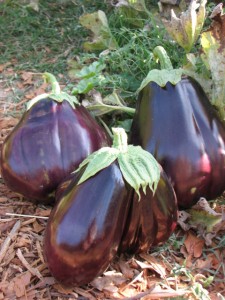
Black Beauty eggplant I love eggplant, but always thought it had to be salted, pressed and fried or baked. Cookbooks always talk about bitter juices that need to be leeched out. The recipe for Coucharas (see recipe list) calls for steaming eggplant until it is very soft so that the pulp can be mashed and combined with other ingredients.
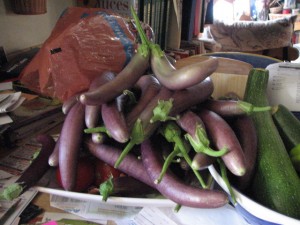
Japanese or Chinese (long) eggplants have few seeds Now with an abundance of eggplant, both Black Beauty and Japanese, in my garden, I looked for some simple eggplant recipes. Maybe everyone else in the world knows how incredible lightly steamed eggplant is, but I just found out!
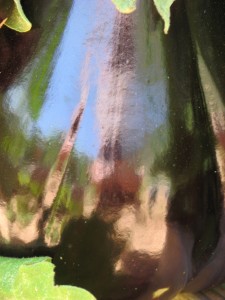
Choose glossy, firm eggplants I took a Black Beauty (globe) eggplant that I’d harvested the week before and was beginning to go soft, cut off the stem end and quartered it lengthwise. I steamed the slices for 8 minutes (no more than 10!).
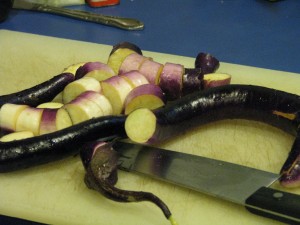
Slice long eggplants into bite-sized chunks The texture was silky and smooth, not at all bitter and incredibly light. Over the top of the quarters I spooned a very easy sauce. The eggplant, which is notoriously spongy, soaked up the sauce. Slicing the eggplant, skin and all, was a dream and eating it was sublime.
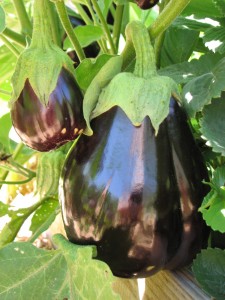
Eggplant is in the same family as tomatoes and potatoes It was so good in fact that I did the same with Japanese eggplant the next night, but instead of quartering them, I cut them into bite-sized chunks, then after steaming poured the sauce over them in a bowl and stirred them around to absorb the sauce. I served both with very thin noodles. Photos of cooked eggplant are rarely delicious-looking, so you’ll have to let your imagination guide you.

An enormous double eggplant! There are many sauce mixtures on the Internet, but here is mine:
Heavenly Steamed EggplantAuthor: Diane KennedyRecipe type: Main DishPrep time:Cook time:Total time:Serves: 2-4Quick, light, tasty, low-calorie and wonderfully different, this eggplant recipe is a gem.Ingredients- One large Black Beauty eggplant or 3 Japanese eggplants
- 2 Tablespoons Rice Wine Vinegar (or other mild vinegar)
- ⅛th cup Bragg's Amino Acids, Tamari Sauce or low-salt soy sauce
- ¼ teaspoon sesame oil
- 2 Tablespoons olive oil
- ½ teaspoon grated fresh ginger
- If you like garlic, dice or grate a small clove and add it in. You can also include chili paste to taste.
- Fresh cilantro (optional)
- Toasted sesame seeds (optonal)
Instructions- Cut stem end(s) off the eggplant
- If using one large eggplant, cut it into quarters long-wise from end-to-end. If using long eggplant, cut into ¾" - 1" bite-sized chunks. Do not peel.
- Steam eggplant for 8-10 minutes until a knife easily slides into the skin; do not overcook!
- Meanwhile, mix all sauce ingredients except cilantro or sesame seeds, if using.
- Plate the eggplant quarters and drizzle the sauce over the top slowly so it absorbs, or put chunks in bowl and mix with sauce, then plate. Offer extra sauce separately.
- Sprinkle with fresh, chopped cilantro and/or toasted sesame seeds.
- Very good with noodles or rice.
-
Mrs. Two Sheds
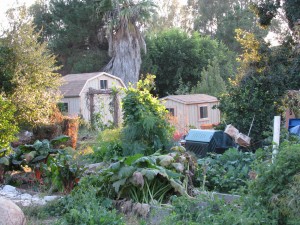
Two sheds seen through the veggie garden Since I had the other enormous and disintegrating sheds taken down last February, freeing up space and providing a lot of materials to recycle into other incarnations on the property, I have had no place to protect my tools. After much debate and shopping around I finally decided on Quality Sheds in Menifee. They build sheds right on the property in a day and cost far less than hiring a carpenter to do it. They offer a warranty on the materials as well.
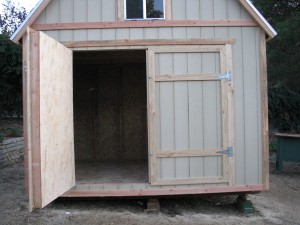
Tall Gambrel with double door In San Diego County you don’t need a building permit if the roof of the structure doesn’t exceed 120 square feet. I purchased a 10 x 12′ tall gambrel shed, with a loft and windows installed by popular window companies (more at Maverick Windows website), as well as a 6 x8′ potting and tool shed with a workbench. Not only did Quality sheds honor an outdated price sheet that I had, but gave me a discount for paying for two sheds and there was a 50% off sale on all ‘extras’ such as windows.

The loft I had these two sheds built for less than half of what a smaller area was bid me by a carpenter, and the large shed was $3,000 less than a bid for a smaller shed.
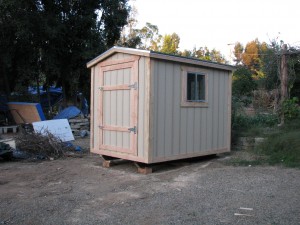
Potting Shed I still have to paint the sheds, and since the ground wasn’t level the sheds are propped up and to drive my mower in I’ll need to make a ramp.
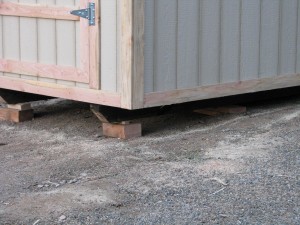
Up on blocks 
A little precarious But finally! Somewhere handy to store my tools and to putter around in.

Workbench in potting shed Neither shed blocks a view, and they look natural where they are. Although I wish that the ground had been leveled when I had asked when the tractor was here digging the pond, because I’ll have to replace the stacked wood props with cement blocks at some point.
Can’t wait to paint and finish the sheds!

Sheds reflecting in the pond… how poetic! - Bees, Birding, Gardening adventures, Heirloom Plants, Other Insects, Permaculture and Edible Forest Gardening Adventures, Photos
Bouquets for Birds and Butterflies

Lilliput zinnia At the beginning of this summer, the new subterranean drip irrigation system was installed on my property. It features tubing with holes at either twelve or twenty-four inches apart. When it runs (from my well) it leaves circles of dampness polka-dotting the soil surface. I had purchased two packets of wildflower seed, one with a selection of plants to attract bees, and the other for butterflies. Mixing them together, I figured that they wouldn’t fare well scattered, at least this year. My daughter and I pressed seed into many of the wet spots and hoped the rabbits wouldn’t notice.
What happened was a delightful surprise, as only a garden can provide. In many locations around the yard grew mixed bouquets of wildflowers.

Mexican sunflower, cosmos, nasturtiums, zinnias, surround a white calla lily If we had separated selected seed and planned the planting, nothing so beautiful would have come of it. Although many species either didn’t emerge or were eaten, the most common survivors were zinnias, cosmos and borage.

Cosmos, borage, zinnias and alyssum. I was amazed and thrilled; I had purchased a borage plant and then fed it to the rabbits (at least, that is what they thought). Here now are borage plants all over the yard, their royal blue, cucumber-flavored flowers dipping modestly behind the flaunting cosmos.

Sweet basil, cilantro, dill and zinnias In fact, I now have several very hearty sweet basil plants that put the carefully cultivated plants in my raised veggie beds to shame. There is also dill and cilantro growing well even this late in the season.

Cosmos, sweet basil, zinnias, borage, camellia balsam, alyssum There are some plants in the bouquets that haven’t reached maturity yet, so there may still be some surprises. The only flower that emerged that I didn’t recognize and had to look up was camellia balsam (Impatiens balsamina). Two stalks of it, one pink and one red, give these ‘arrangements’ a vertical line.
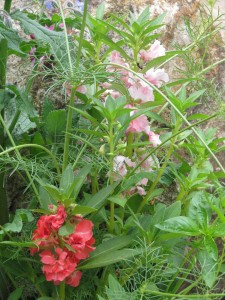
Camellia balsam (Impatiens balsamina) Although not all of these wildflowers are native to San Diego, or even California, they provide food for birds, bees and are host plants for butterflies, providing the caterpillars food, a place to form their chrysalises, and nectar for the mature butterfly. Bees like small flowers with little drops of nectar too small to drown in, with a nice landing pad of a petal close by. Everything in the carrot family works well. Here are some suggested flowers to plant:
For butterflies:
Mexican lupine, Mexican sunflower, borage, calendula, camellia balsam, scabiosa, cornflower, milkweed, parsley, crimson clover, aster, coreopsis, cosmos, prairie gayfeather, purple coneflower, sweet sultan, sneezeweed, sweet William, bishops flower, black-eyed Susan, dill, snapdragon, yarrow, bergamot, cleome, verbena, and butterfly bush.
For bees:
Cosmos, sunflowers, borage, coriander, Siberian wallflower, dill, coreopsis, poppies, gaillardia, zinnia, sweet basil, purple prairie clover, globe gillia, catnip, lemon mint, black-eyed Susan, goldenrod, lavender hyssop, bergamot, yarrow, mint, California buckwheat.
Be sure to plant flowers that bees love away from paths and walkways if you or your family want to avoid contact with the bees.
-
Oh, Whatta Night
-
First Rain
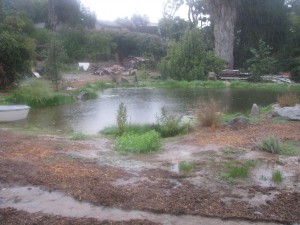
Rainfall on the pond The first week of October and we’re having a day of heavy rain… almost unbelievable. Normally October in San Diego is high fire season. The brush is crisp from months of drought and high temperatures, and then the Santa Ana winds begin: wild dry winds that blow east to west from the deserts, full of static and mad gusts that turn brush fires into firestorms.
My property is a watershed, funneling rainwater from the street through to the streambed in the barranca below, taking all my topsoil and some of the embankment with it. This year I had the beginnings of a permaculture garden installed to remedy this pattern. By deepening the loam and placing berms around plant guilds water is encouraged to pool up and soak in rather than run off. Overflow is channeled through a series of dry ponds which allow water to soak into the ground. From there it is channeled safely down to an overflow into the stream. Today was an early test of what has been worked on since Feb. 1.
The tilling, mulching and berming done by the crew of landscape architect Roger Boddaert proved successful.
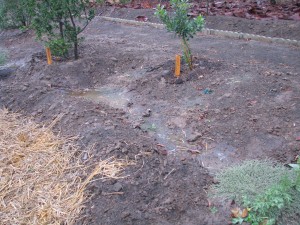
Berms hold water back so that it may soak into the loam The soil has a high clay content, which was good news when digging the large pond because it held water without a liner. It is bad news for other areas of the garden where water is pooling up instead of sinking in. I was able to take note of these areas this afternoon so that they could be drained and mulched for more absorption.
Aquascape, the company that installed the series of ponds, is still planting and maintaining the waterways. Jacob came out in the rain and watched it flow, shaping and fortifying as the force of the rain and thus the volume increased.

Jacob helping water flow Water flowed under the fence from the street, but instead of flooding a cement culvert as it used to do, it is channeled down to the ponds.
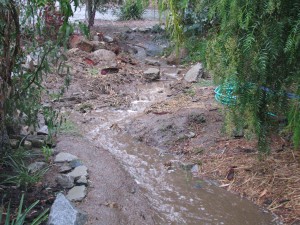
Street run-off enters under the fence 
Blocked by debris, water floods past the bridge Silt and debris blocked water flow under the bridge, and was eroding the area by the structure called the Nest. I cleared the debris and raked rocks and silt to the weak side, and that fixed the problem temporarily.
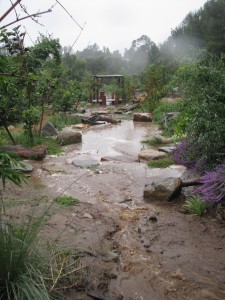
Rainwater flowing into the first 'dry' pond Water quickly filled the first dry pond; with the high clay content, water percolates but does it slowly.
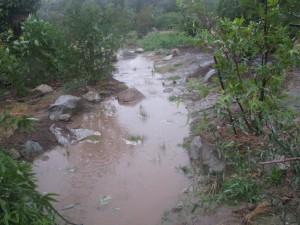
'Dry' ponds filling and slowing run-off 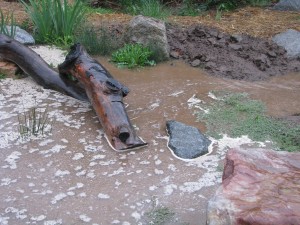
Logs and rocks are ornamental and slow water flow 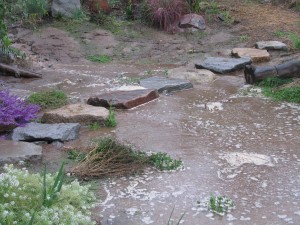
Normally dry, the stone crossing is now almost underwater 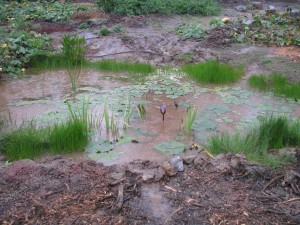
The little pond is rapidly filled. As water reached the small pond, which wasn’t intended to permanently hold water but the clay had a different idea, the sides had to be shored up and the overflow diverted.
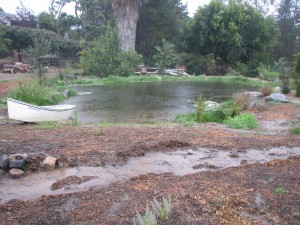
Water is diverted from the little pond around the big one Extra floodwaters aren’t being diverted into the large pond because we don’t want it filled with silt, and we don’t want it overflowing rapidly and eroding the sides. Instead the water flows through a channel around the large pond, then down to a prescribed place to flow out and over the embankment to the stream below.
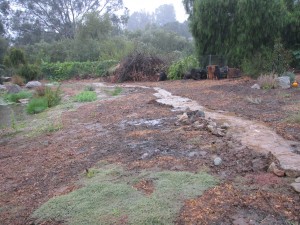
Overflow is channelled past the ponds and out to the natural stream below Some areas of heavy erosion had been filled and supported, and as of six this evening they looked wet but not iffy. What a night of heavy rain will do, I’ll have to see in the morning. I am very lucky to have this type of
rain early in the season. It has been heavy enough to cause significant water flow to help shape the watercourse and show weak spots, and the rain will be reduced to showers tomorrow then clear up, so repairs and improvements can be made before true flooding happens later in the year or early in the next.Although much more water is being held on the property, and topsoil is not being lost, it still pains me to see so much rain channeled out to the stream. Rainwater is a neutral Ph, and carries nitrogen (especially when
there is lightning). It is the best possible water for plants, as well as for human consumption and bathing. In side-by-side comparisons with tap water, plants watered with rainwater flourish far beyond the growth of the others. I’m greedy to hold that water onto my property, letting it soak as deeply as possible for tree roots to use far into the year. As the newly planted trees grow, their roots will help hold water and soil. As their leaves drop the mulch levels will raise, aided by compost and mulch that I will be constantly adding, and the soil will become more absorbent farther down. Each rain should have less runoff and more absorption. This rain has shown a great success with the garden, but I know it is only the beginning.





